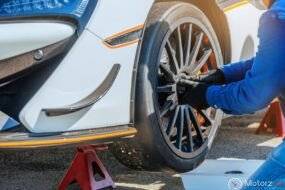Winter Driving Wisdom Tips for Navigating Snowy Roads can be a beautiful yet treacherous experience, especially when snowy roads pose challenges for even the most experienced drivers. Snow and ice can turn your daily commute or road trip into a hazardous adventure. However, with the right knowledge and preparation, you can safely navigate snowy roads and ensure your winter journeys are enjoyable and accident-free.
Prepare Your Vehicle
It’s crucial to ensure your vehicle is winter-ready Consider switching to winter tires, which are designed for better traction on icy and snowy surfaces. Cold weather can put extra strain on your vehicle’s battery. Antifreeze Verify that your antifreeze levels are adequate to prevent your engine from freezing. Replace worn wiper blades and fill up your windshield washer fluid reservoir with a winter formula that won’t freeze. Brakes and Lights. Make sure your brakes are in good working order, and all lights are functioning correctly.
Plan Ahead
Before setting out, plan your route and check the weather forecast. Avoid unnecessary travel during severe winter storms, and if you must go out, inform someone about your destination and estimated arrival time. And carry a fully charged mobile phone, a flashlight, and some extra warm clothing, just in case.
Slow Down and Increase Following Distance
One of the most important Winter Driving tips is to reduce your speed. Slow down to match road conditions, and leave plenty of space between your vehicle and the one in front of you. In snowy conditions, it can take significantly longer to stop, so maintaining a safe following distance is crucial to prevent accidents.
Be Gentle with Controls
Tips for Navigating Snowy Roads, Avoid sudden movements with your steering wheel, brakes, or accelerator. Smooth, gentle actions will help you maintain better control of your vehicle. Gradually accelerate, brake gently, and steer smoothly to prevent skidding.When you’re driving on snow-covered roads, think of it like you’re dancing with your car. No sudden, jerky movements—smooth and graceful is the way to go
Use Proper Lights
Visibility is often reduced in snowy weather, so make sure your headlights and taillights are on. Turn on your low-beam headlights, not your high beams, as they can reflect off the snow and impair visibility further.High beams might seem like a good idea, but they can bounce off the snowflakes like disco balls, turning your drive into a blinding light show.
Clear All Snow and Ice
Winter Driving Before driving, remove all snow and ice from your vehicle’s windows, roof, hood, and lights. Snow blowing off your car can obstruct your vision or create hazardous conditions for other drivers.Give it a good pre-drive makeover—clear those windows, shake off the snow from the roof, and make sure those lights are twinkling, not buried. It’s not just about looking good; it’s about keeping the road runway safe for everyone else.
Know How to Handle Skids
Skidding can happen on slippery roads. If you find yourself in a skid, remember not to panic. Steer gently in the direction you want to go and avoid slamming on the brakes or accelerator. Practice skid recovery techniques in a safe, empty parking lot to gain confidence in handling such situations.
Beware of Black Ice
Black ice is nearly invisible and forms on road surfaces, making them extremely slippery. Be cautious when temperatures hover around freezing, and the roads appear wet, as they could be coated in black ice. Stay safe and take the necessary precautions to ensure you arrive at your destination unscathed, regardless of the winter weather conditions.
Watch for Snowplows and Salt Trucks
Snowplows and salt trucks work diligently to clear the roads, so give them plenty of space. Avoid passing them unless it’s safe to do so, and be patient while they do their job. Snowplow drivers appreciate your cooperation in making the roads safer for everyone.Think of snowplow drivers as the unsung heroes of winter—they’re out there battling the elements to keep the roads safe for all of us. Show them some love by giving them the space they need.
Keep an Emergency Kit
In addition to the essentials mentioned earlier, keep an emergency kit in your vehicle during the winter months. This kit should include items like a blanket, non-perishable food, water, a first-aid kit, and basic tools.Toss in a cozy blanket, some non-perishable snacks (maybe a stash of hot cocoa packets), a water supply to keep you hydrated, a first-aid kit just in case, and some basic tools to play the hero when your car needs it.
Conclusion
Winter Driving presents unique challenges, but with proper preparation and caution, you can navigate snowy roads safely. Remember to prepare your vehicle, plan ahead, reduce your speed, and practice gentle control. By following these winter driving tips and exercising patience and good judgment, you can make your winter journeys enjoyable and minimize the risks associated with snowy roads.
Prepare Your Vehicle your Winter Driving
Tips for Winter Driving
winter driving canada
winter driving toronto
winter driving usa











